by Briscoe White | Feb 11, 2011 | Containers, Gardening, Growing, Herbs, Indoor Gardening, Life on the Farm, Miscellaneous, Urban Gardening |

Tons of cat toys are packed with Catnip to perk your cat's interest!
Looking for a great all natural way to treat your favorite feline? Try Catnip! Often found packed into the plush insides of a cute little toy or sold in dried form at local pet stores, catnip makes most cats pretty crazy. Over eighty percent of cats are affected by the chemical component Nepetalactone, which is found in the essential oils of this perennial herb. A combination of genetics and age determine whether your felines will fiend for Catnip, as studies show that kittens don’t seem to respond until around the age of three months. Though not explored extensively, there are many cases of dogs and even some bears who find the scent of “nip” irresistible. Reactions range from sleeping and drooling, to frantically pouncing and running around, and cats seem to also experience heightened tactile sensations which may include being rubbed on their face, petted or brushed to excess.
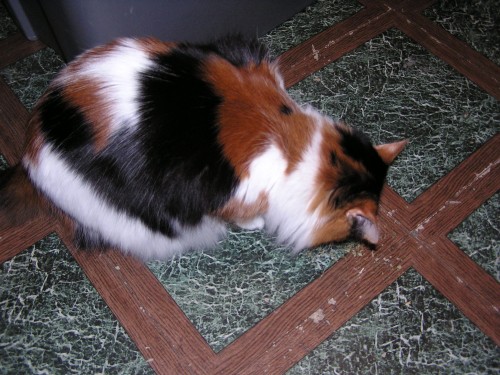
Our Media Director's cat, Sophie, eating dried Catnip. She likes the fresh stuff better!
Also known as an excellent natural insect repellent, the essential oils are often found in many DEET-free bug sprays. If making your own concoction to deter pests, try using Lemon Catnip for a fragrant citrus aroma. Catnip also has a history as a medicinal herb for its sedative properties and makes a soothing tea to help you relax, much like Valerian, an herb known to mellow you out and known commonly as “the poor man’s Valium”. Slightly numbing, Catnip is also reputed to strengthen immunities to fend off colds, fevers and the flu, and also calms an upset stomach. Growing fresh Catnip for your kitties isn’t just fun and games. The vitamins and nutrients they get from eating the raw plant is great for their bodies, and the plant itself can help cause any indigestion which may result from some store-bought foods.
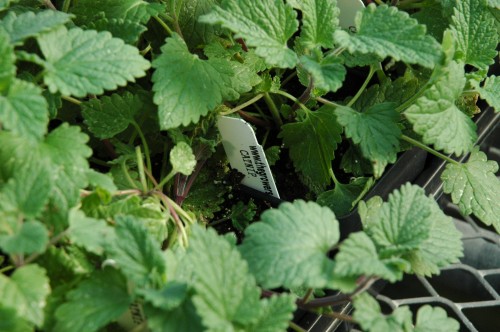
Our Catnip is all natural and because we don't use harsh chemicals, it's purrrrrfectly healthy for your cat!
If you plan to grow Catnip for your cats indoors, you may want to plant two pots, one to keep out of their reach outdoors, and one for them to enjoy inside, but make sure to swap them occasionally so they don’t completely attack the indoor pot! If you’re growing it outdoors, be aware that neighborhood cats may be flocking to your garden. To prevent their frantic frolicking from interfering with other, more tender plants that may be growing nearby, either plant your catnip in a well-drained, separate area of its own, or build a fence around your garden. (If you have problems with container-planted Catnip, try placing it in a large, metal bird cage or dog kennel, where the kitties can’t plow through it all and destroy your plant.) If you want to really encourage your cats to love you more, try planting Catmint, Lemon Catnip and Valerian in your garden. All three of these great herbs are kitty-friendly, human-friendly and make a really calming tea. Treat your cats the natural way and grow them a garden full of treats!
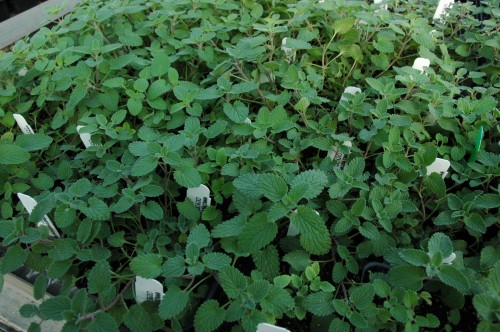
Catmint is another great herb to get your felines frisky!
by Briscoe White | Feb 3, 2011 | Basics, Containers, Gardening, Growing, Herbs, Indoor Gardening, Seeds, Urban Gardening |
Nasturtiums are typically started from seed– but why do the sowing yourself, when we are happy to sow them for you? While most of the country is experiencing another record-setting snowy winter, your nasturtiums are in good hands here on the farm, safe in our warm and well-tended greenhouse. While most people are ordering seeds that ship immediately, we’re nurturing and hand tending our plants with care until it is warm enough to ship them via mail couriers like Fedex, this spring. This way, you get healthy, happy plants that arrive on your doorstep and are ready to plant or pot, instead of seeds that have battled the rigors of the icy weather AND the postal system. Our nasturtiums are a great example. Below, see us starting these little guys on their life journey.
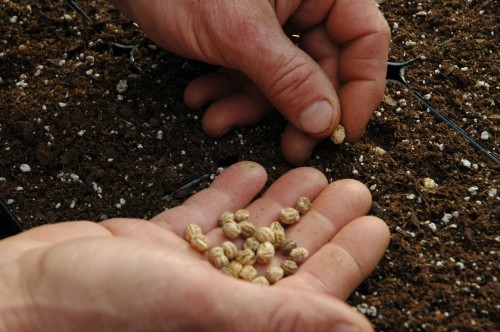
Sowing Nasturtium seeds
When spring arrives at last and you receive your Nasturtiums, plant them in well-drained soil and full sun. They are easy to grow, and do not require a lot of maintenance. In fact, they do better with a little neglect. They like weekly waterings, or whenever soil is dry to the touch.
Nasturtium leaves have an interesting watercress flavor to them, and are a wonderful addition to salads and cheese sandwiches. Use them to spice up cream cheeses, dips, or egg dishes. Colorful nasturtium flowers are not only beautiful, but are also edible. Many health food stores carry these edible flowers– but at a high price! Take advantage of your nasturtiums by picking their flowers soon after they open up. The flowers can be served whole as a gorgeous decoration to cakes, or petals can be sprinkled on salads.
If you would rather keep your blooms on your plant, be sure to remember to pick off dead blooms. This will allow your nasturtium to bloom continuously. If you don’t dead-head them, they will start to go to seed, as our social director Caroline recently discovered! You can read about her experience in our previous blog. These seeds can also be pickled and used as you would use capers.
by Herb Exchange | Feb 1, 2011 | Containers, Gardening, Growing, Herbs, Indoor Gardening, Urban Gardening |
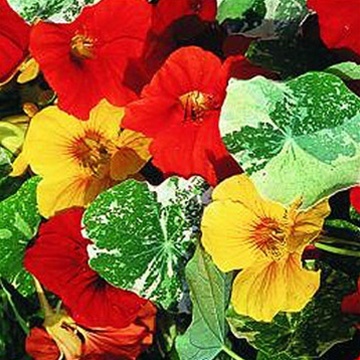
'Alaska Mix' Nasturtium
*Our Marketing and Social Media Director, Caroline has been attempting to turn her brown thumb green since she began working here, and it looks like she may be getting the hang of it!*
This past fall I salvaged some ‘Alaska Mix’ and ‘Empress of India’ Nasturtiums who were at the end of their season and growing closer to being composted. I decided it would be a great winter project to try to keep these creeping beauties alive in my kitchen for their culinary value (their leaves, blooms and seeds are all edible!) and it would be a great test to see how green my thumb had grown since joining The Growers Exchange team. Though light is a little scarce since neighboring buildings block it for most of the day, and my cats terrorize the curtain-like foliage by using it as cover (and as a snack), I’ve managed to keep the majority of these guys green and somewhat healthy! It’s been interesting to see how at different points of the day the foliage will crane their stems to follow the sunlight as it moves across my kitchen, like these herbs have a mind of their own!
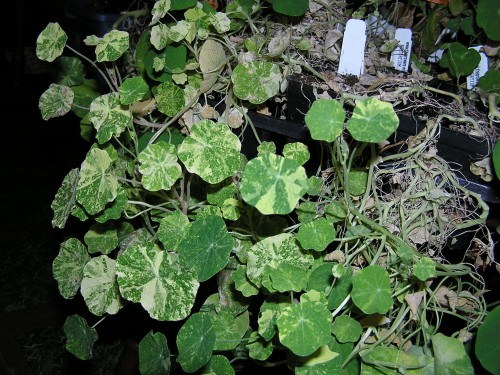
'Alaska Mix' Nasturtium variegated foliage
While watering the other day, I readjusted some of the variegated, viney leaves to allow more of the ‘Alaska Mix’ to get more light and two, hard, green little nodes fell off! At first I thought this was some kind of pest or bug that had invaded my little indoor oasis, but after some research and thorough poking with my finger, I realized that my plant had started to go to seed. These light green seeds are rounded on one side and sort of pinched and puckered looking on the opposite side, and can apparently be prepared with hot vinegar to create “poor man’s capers”. These pretty annuals have been trying to go to seed all season and thus, end their life cycle. Keep yours blooming by continuing to prune dying foliage back and to deadhead them which will prevent the process of going to seed and keep them vibrant for much longer. I’m going to try to plant these alien-looking little seed pods and see if I can sprout some more of these awesome spiller herbs!
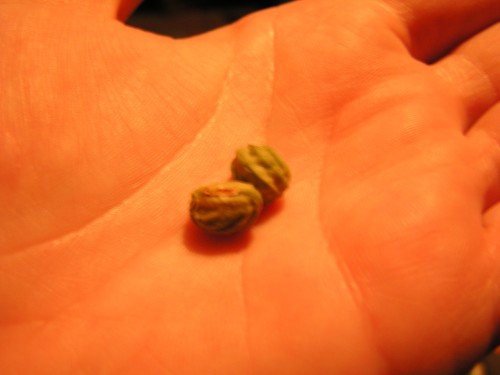
'Alaska Mix' Nasturtium seeds
I also recommend growing these indoors to any novice or brown thumb, like myself, or to anyone who has kids. The Nasturtium‘s non-toxic, edible leaves make a beautiful contrast to their bright, continuous blooms, and because they grow quickly and can take a little abuse or neglect. Though I need to repot mine, as they’re getting too big for their britches, I’d recommend a hanging pot or container to hang them in a sunny window. This way, their leaves and tendrils can have room to stretch and grow, and they’ll be out of the way of little furry monster who may try to dine on them. These Nasturtiums, along with a few Calendula (which I haven’t been as successful with) have been a true delight during these dreary, cold months. Just a little green around your home can make a huge difference in picking up your spirits while it’s gross and gray out. Try growing some today– they’re a great first time herb plant!
by Briscoe White | Jan 19, 2011 | Containers, Gardening, Growing, Herbs, Indoor Gardening, Miscellaneous, Urban Gardening |
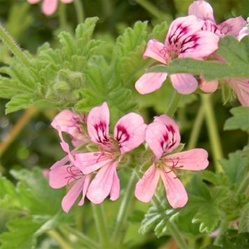
There are over 200 variations of Pelargonium, each with a specific scent and beauty.
Oh Scented Geraniums, so lovely, so fragrant, so easy to grow, so…not even geraniums at all! Scented Geraniums are not considered “true” geraniums and are of the genus Pelargonium, but their leaves do resemble geraniums and they share the same botanical family. Their success as portable container plants make them favorites in almost any climate, both inside and out. Scented Geraniums are native to South Africa, but became hugely popular with Europeans in the early 16th century. Thomas Jefferson was known to grow several varieties at the White House, and here at The Growers Exchange, we sell three of our favorite varieties: Citronella, Old Fashioned Rose, and Atomic Snowflake.
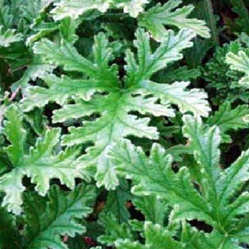
The sweet Citronella fragrance comes from the plant's foliage, not its blooms.
Citronella is probably the most well-known, due to its use as a safe and natural insect repellent. Oil from this plant is commonly extracted from the plants and added to home-made and over-the-counter products. Many gardeners also plant bushes of Citronella in their gardens, and simply swipe the mass with a broom to bruise the foliage, which releases the plant’s fragrant, citrusy aromas. Though it’s sometimes debated whether this actually works effectively as a repellent, when planted in large quantities, we’ve noticed a significant decrease in mosquitoes around our patio on warm summer evenings. We’ve also found that the lemon and rose varieties are the best for container planting. They will grow compactly but a little goes a long way! Their perfume will freshen your patio or home as long as you keep it nice and happy with plenty of sun and adequate watering.
Great in the garden but also quite content in a hanging container or pot, be sure to provide well-drained soil, and not to over-fertilize. It is actually better to under-fertilize than over-fertilize these aromatic beauties, as soil excessively rich in nutrients (especially Nitrogen) can cause leaves to be less fragrant. Fertilize from spring through fall for best results, and fight the urge to fertilize during the winter. This is when the herb naturally slows down production, and fertilizing at this point may trick it into a false growing period, which will result in less than favorable bloom and fragrance production.
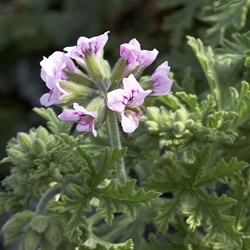
Clusters of sparse blooms are a defining characteristic of the Pelargonium.
Thriving in bright light, be sure to place them in a southern-facing window with ample mid-day sunlight if growing indoors. Preferring daytime temps around 70 degrees, these continuous bloomers will flower until the first frost. Overall, scented geraniums are quite drought-tolerant and therefore relatively easy to grow plants. Do not allow them to completely dry out before waterings, but at the same time be sure not to over-water, as constantly saturated soil can cause root rot problems. Clay pots help gardeners who tend to get a bit water-happy, as they allow excess water to seep out through the porous clay. Moisten only the soil when needed, rather than watering the whole plant, to ensure that it gets just enough water without drowning.
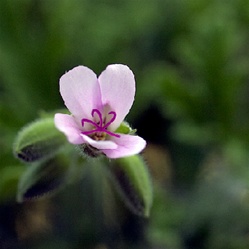
Though they vary in shape, size and color, every variety shares the same five-petaled bloom design.
Prune in early spring for fuller blooms and foliage. Cut right above the node with clean, sharp shears. Pinching and pruning redirects the plant’s energy back into the remaining stem, forcing it to sprout new, thicker, fuller growth. Early spring pinching takes advantage of the plant’s natural growing season, allowing the plant plenty of time to grow before its natural slower-growing-months of winter. They are also a popular bonsai plant and can be pruned and trained to resemble a more fragrant replica of a bonsai tree.
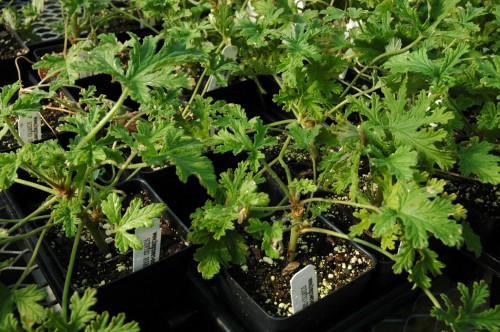
Growing Scented Geraniums is easy if you give them lots of sun and adequate water.
Scented Geraniums can be germinated from seeds or propagated from stem cuttings. When growing from seed, they typically germinate quickly, sprouting in a mere few days to a few weeks. Keep the seedlings out of direct sunlight as they will not grow if the soil is warmer than 75 degrees. From trial and error, it seems that plants started from seed rather than propagation tend to be stronger, and resist disease and cold temperatures better. After planting, you should see blooms twelve to sixteen weeks after the seeds are sown. If propagating from cuttings, make sure to start in early fall, and to cut four to six inches from a healthy, mature plant just below where leaves or nodes are growing. Taking a large enough cutting, typically containing three to four leaves, should be a big enough piece that should stand any stress from the transplanting process. Also, once the new plant has established a root anchor and is beginning to mature, be wary when pruning. Pinch the growth tips back by mid-February or the beautiful blooming clusters will be postponed in flowering.
by Briscoe White | Jan 17, 2011 | Containers, Gardening, Growing, Herbs, Indoor Gardening, Miscellaneous, Urban Gardening |
When talking about Rosemary, my mind immediately wanders to the kitchen. That savory piney smell that wafts out from under pot lids, or from a steaming roast or loaf of bread just out of the oven. One of the most basic culinary herbs, Rosemary has remained popular for many reasons since its early use in Greek and Roman cultures where it was used for everything from repelling evil and sickness to symbolizing fidelity between lovers. Though long believed that if grown in kitchen gardens, Rosemary represented the strength of the matriarch of the home, in modern times Rosemary has lost its gender bias and is a culinary herb enjoyed by all. A member of the Mint family, Rosemary is a cousin to Basil, Oregano and Lavender, which explains why they grow and taste so great together! Yet, one of the best reasons to love Rosemary is its ability to grow in many different climates and zones and for its versatile usage and easy care. To give you an idea of what we mean, here’s a crash course in Rosemary!
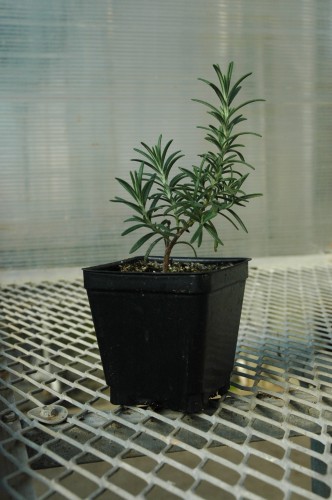
By far the most cold-hardy variety, ‘Arp’ has thin, silvery, needle-like leaves. It’s the plant’s uniquely sized foliage that I believe makes it so temperature-tough, as with less surface area the plant is able to conserve its energy and essentially becomes impenetrable to cold weather. Aromatic and easy to grow, this variety is great because it gives chefs who live in more northern zones, like Zone Six, a delicious culinary option when other herbs can’t survive. Also quite drought resistant, try planting Rosemary ‘Arp’ as a low-growing hedgerow. Brushing past it will release its wonderful scent.
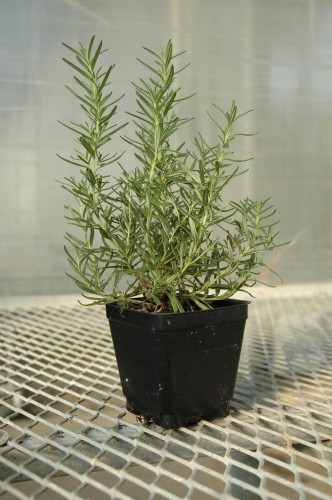
Typical of the traditional Rosemary foliage, ‘Hardy Hill’ is the second most cold tolerant variety and produces characteristic dark green, needle-like foliage. A terrific culinary herb, ‘Hardy Hill’ will survive in cold areas as low as Zone Seven and is drought tolerant. Great on potatoes, in stews and breads, or to season meats, ‘Hardy Hill’ really comes through when the temperatures are low. Similar to Rosemary ‘Arp’, yet possessing a darker color, ‘Hardy Hill’ grows well in containers as well as in your garden, and can be grown indoors during extremely cold temperatures.
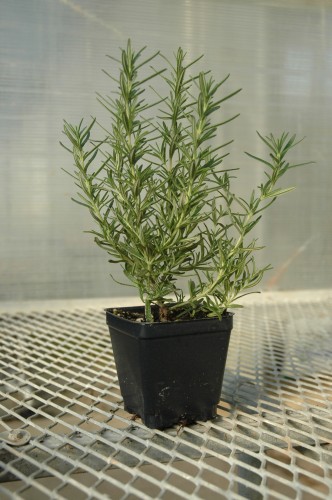
Very similar in habit and look as ‘Hardy Hill’, without the extreme hardiness. ‘Salem’ is a more cold sensitive variety of Rosemary but is more useful in the kitchen. Not only can you use its flavorful foliage to lend a savory distinction to your favorite dish, but you can use its woody branches for barbecue skewers. We actually tried this over the summer when we had lamb kabobs. The natural fragrance and flavor of the Rosemary infused the meat as it cooked over the grill, releasing tons of taste and perfuming the air. Give this a shot the next time you’re grilling pork, lamb or beef. If you don’t feel like making skewers, try sinking the sticks into the full piece of meat to really cook the amazing aroma into your dish. Perennial in Zone Seven through Zone Ten, ‘Salem’ has light, almost smoky green foliage.
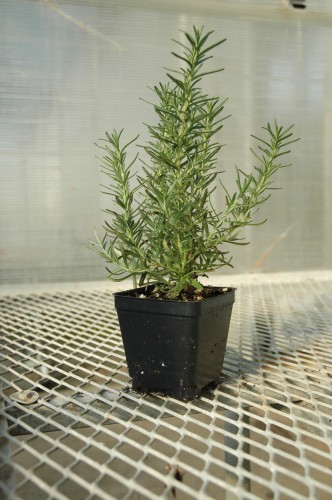
By far the most beautiful of the Rosemary varieties we grow! ‘Tuscan ‘Blue’ produces tons of beautiful blue flowers and lush foliage, making this variety the ideal Rosemary for topiaries. As useful in the kitchen as it is beautiful in the garden, ‘Tuscan Blue’ is used to flavor dishes in many of the same ways as its hardier cousins. Also a terrific indoor herb because of its lovely fragrance and glossy, dark green leaves, ‘Tuscan Blue’ has an erect habit and grows best in Zone Eight through Zone Ten. It’s sometimes best to container plant this delicate beauty for moving indoors, as even cool evening temperatures may upset it.
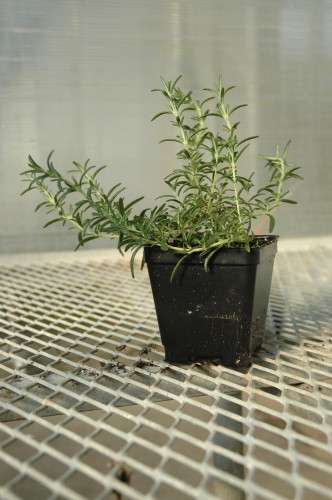
A great ground cover Rosemary, ‘Prostrate’ is not terribly hardy, but where it’s warm enough, this great variety won’t let you down. A landscaper’s dream, ‘Prostrate’ can be planted as a stand alone landscaping shrub, so it doesn’t take up room in your garden. Fashionable and functional, just make sure to plant it in close proximity to your kitchen for easy use. This great dual purpose Rosemary will brighten your yard and your kitchen without using valuable garden space. Try planting this along a garden wall or in a large planter and let it spill over the edge to create a culinary cascade!
Regardless of which Rosemary you prefer, they all have terrific culinary and aromatic value. Planting them in your garden or keeping them indoors will provide you with a delicious herb for your favorite recipes as well as a wonderful fresh fragrance that can’t be matched. Try using your favorite Rosemary variety in wreaths, potpourris, or as centerpieces. By adding Rosemary to a mesh sachet, you can place it in your bath for a soothing soak or in your drawer to freshen up your laundry. You can even extract the oils and use it as an all natural perfume that will actually condition your skin! We love working with this versatile herb in the greenhouse, as we always leave smelling of its sweet, piney scent. The possibilities for using Rosemary are endless! No matter what zone you live in, we have a Rosemary for you, so don’t be discouraged by your location!
by Briscoe White | Feb 26, 2010 | Exploring, Gardening, Growing, Inspiration, Urban Gardening |
I had to pick up some greenhouse supplies today. In the warehouse park where our supplier is located is one of those little areas time seems to have forgotten. At the rear of the park are a few lots no one wanted some thirty years ago where the park was built out.
Open land just sitting there is an open invitation to many urban farmers. This unwanted couple of acres has been converted to individual plots. Like everything else, the gardens are frozen for now, but come spring this place will look like an Asian market for vegetables. Everybody seems to have their own plan; some grow all peppers or all greens while others grow a diverse garden.

All the fences and cold frames are made of discarded materials. Most of the crops grown are annual plants, started from seed. This summer I will get a photo of the crops, but for now it is still too cold to garden.



















